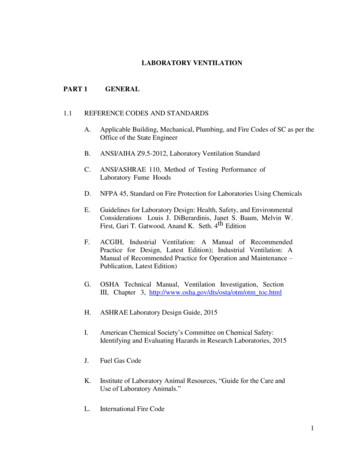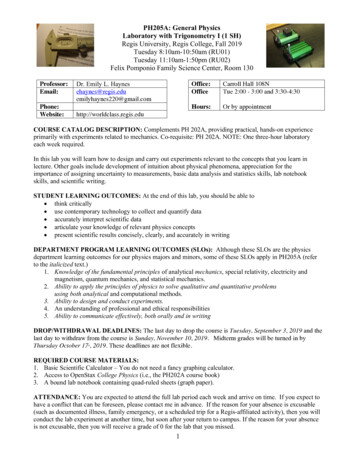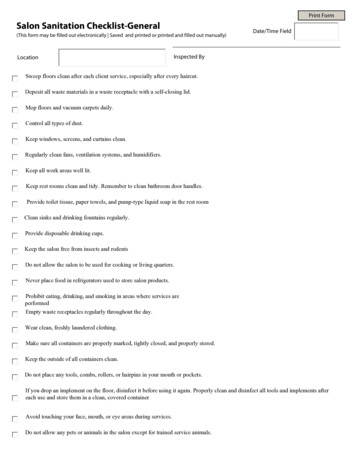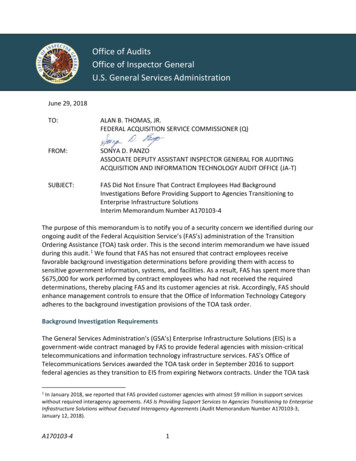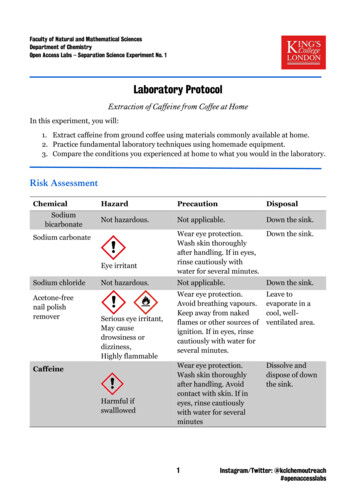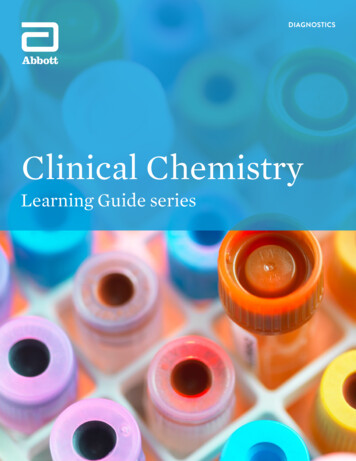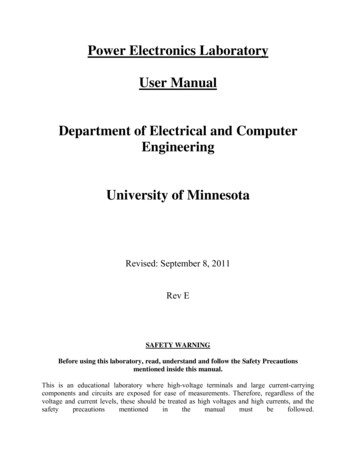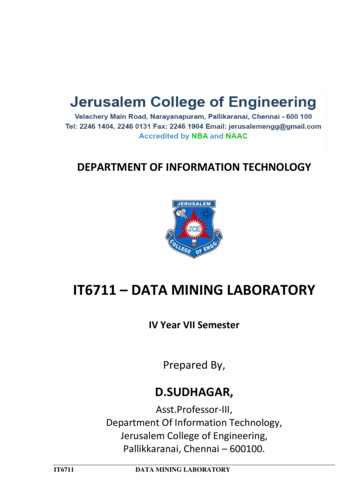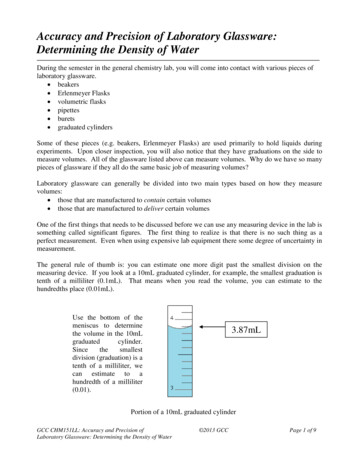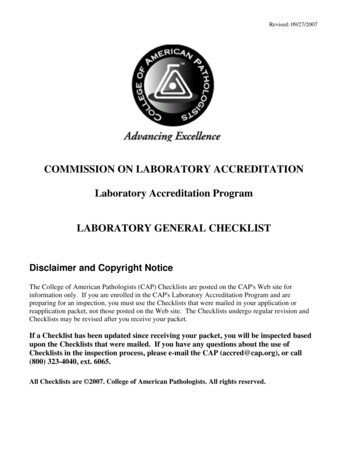
Transcription
Revised: 09/27/2007COMMISSION ON LABORATORY ACCREDITATIONLaboratory Accreditation ProgramLABORATORY GENERAL CHECKLISTDisclaimer and Copyright NoticeThe College of American Pathologists (CAP) Checklists are posted on the CAP's Web site forinformation only. If you are enrolled in the CAP's Laboratory Accreditation Program and arepreparing for an inspection, you must use the Checklists that were mailed in your application orreapplication packet, not those posted on the Web site. The Checklists undergo regular revision andChecklists may be revised after you receive your packet.If a Checklist has been updated since receiving your packet, you will be inspected basedupon the Checklists that were mailed. If you have any questions about the use ofChecklists in the inspection process, please e-mail the CAP (accred@cap.org), or call(800) 323-4040, ext. 6065.All Checklists are 2007. College of American Pathologists. All rights reserved.
College of American PathologistsRevised: 09/27/2007LABORATORY GENERALOUTLINESUMMARY OF CHANGES .3INSPECTION TECHNIQUES – KEY POINTS.6PROFICIENCY TESTING .8QUALITY MANAGEMENT .10SPECIMEN COLLECTION, DATA HANDLING, AND REPORTING .25COLLECTION MANUAL AND OTHER DOCUMENTATION .26PHLEBOTOMY.29TRANSPORT SERVICES .35REQUISITIONS AND SPECIMEN RECEIPT/HANDLING/ASSESSMENT.38REPORTING OF RESULTS .44QUALITY OF WATER AND GLASSWARE WASHING .54TEST METHOD VALIDATION.58METHOD PERFORMANCE SPECIFICATIONS .58REFERENCE INTERVALS .62LABORATORY COMPUTER SERVICES .63COMPUTER FACILITY .64LIS/COMPUTER PROCEDURE MANUAL .66HARDWARE AND SOFTWARE .67SYSTEM MAINTENANCE .69SYSTEM SECURITY .70PATIENT DATA .72AUTOVERIFICATION .75DATA RETRIEVAL AND PRESERVATION.77INTERFACES .80NETWORKS .83TELEPATHOLOGY .83PERSONNEL.86TECHNICAL SUPERVISORS .86GENERAL SUPERVISORS .88ALL PERSONNEL .89PHYSICAL FACILITIES .94SPACE.94ENVIRONMENT.95COMMUNICATIONS .96INVENTORY AND STORAGE OF SUPPLIES .97POWER .98LABORATORY SAFETY.99MANUALS AND RECORDS .99PHYSICAL INSPECTION OF THE LABORATORY.118LABORATORY GENERAL (Web File)Page 2 of 130
College of American PathologistsRevised: 09/27/2007SUMMARY OF CHANGESLABORATORY GENERAL Checklist9/27/2007 EditionThe following questions have been added, revised, or deleted in this edition of the checklist, or in thetwo editions immediately previous to this one.If this checklist was created for a reapplication, on-site inspection or self-evaluation it has beencustomized based on the laboratory's activity menu. The listing below is comprehensive; thereforesome of the questions included may not appear in the customized checklist. Such questions are notapplicable to the testing performed by the laboratory.Note: For revised checklist questions, a comparison of the previous and current text may be found onthe CAP website. Click on Laboratory Accreditation, Checklists, and then click the column markedChanges for the particular checklist of interest.NEW Checklist 24GEN.72075Effective 200604/06/2006REVISED Checklist 067GEN.41096GEN.41303Effective 200709/27/2007LABORATORY GENERAL (Web File)Page 3 of 130
College of American .20375GEN.41320GEN.53400GEN.71000Revised: DELETED Checklist N.54450GEN.20369GEN.30050Effective 200604/06/200604/06/2006LABORATORY GENERAL (Web File)Page 4 of 130
College of American PathologistsRevised: 09/27/2007The checklists used in connection with the inspection of laboratories by the Commissionon Laboratory Accreditation (“CLA”) of the College of American Pathologists have beencreated by the College and are copyrighted works of the College. The College hasauthorized copying and use of the checklists by College inspectors in conductinglaboratory inspections for the CLA and by laboratories that are preparing for suchinspections. Except as permitted by section 107 of the Copyright Act, 17 U.S.C. sec.107, any other use of the checklists constitutes infringement of the College’s copyrightsin the checklists. The College will take appropriate legal action to protect thesecopyrights.CONTINUING EDUCATION INFORMATIONBeginning January 2008, you may earn continuing education credits (CME/CE) by completing anonline Inspection Preparation activity that includes review of this checklist.Prior to reviewing the checklist, log on to the CAP Web site at www.cap.org http://www.cap.org ,click the Education Programs tab, then select Laboratory Accreditation Program (LAP) EducationActivities, and Inspection Preparation for complete instructions and enrollment information.PARTICIPANTS ARE REMINDED THAT THE CONTENTS OF THIS CHECKLIST APPLYTO ALL SECTIONS OF THE LABORATORY. INSPECTION OF A DISCIPLINE-SPECIFICAREA (e.g., ANATOMIC PATHOLOGY) IS NOT LIMITED TO THE CONTENTS OF THEDISCIPLINE-SPECIFIC CHECKLIST, BUT INCLUDES ALL APPLICABLE PORTIONS OFTHIS LABORATORY GENERAL CHECKLIST. ALL SECTIONS OF THE LABORATORYMUST BE FAMILIAR WITH THESE CONTENTS.NOTE on CAP PATIENT SAFETY GOALS:CAP has developed a core set of laboratory patient safety goals for pre- and post-analytic laboratoryprocesses. These goals are:1.a.b.c.2.a.b.c.d.3.4.Improve patient and sample identificationAt the time of specimen collectionAt the time of analysisAt the time of results deliveryImprove the verification and communication of life threatening or life alteringinformation regardingMalignanciesHIV and other infectionsCytogenetic abnormalitiesCritical resultsImprove the identification, communication and correction of errorsImprove coordination of the laboratory patient safety role within healthcareorganizations (nursing, administration, POCT personnel, providers)LABORATORY GENERAL (Web File)Page 5 of 130
College of American PathologistsRevised: 09/27/2007The checklists contain multiple questions that deal with the above goals. Laboratories shouldemphasize these goals in their quality management activities. Approaches include monitoring activitiesrelated to the goals (for example, number of mislabeled specimen containers), withcorrective/preventive action as necessary; investigation of sentinel events, with corrective/preventiveaction as necessary; and evaluation and revision of processes and procedures affecting the goals, tooptimize laboratory performance. The laboratory should document how it addresses these goals.The inspector should pay particular attention to checklist questions that address the above patientsafety goals, and communicate any findings to the inspection team leader, who will address patientsafety goal issues with the laboratory ***********************INSPECTION TECHNIQUES – KEY ********************I. READ – OBSERVE – ASK – the three methods of eliciting information during the inspectionprocess. These three methods may be used throughout the day in no particular order. Plan theinspection in a way that allows adequate time for all three components.READ Review of Records and DocumentsDocument review verifies that procedures and manuals are complete, current, available to staff,accurate and reviewed, and describe good laboratory practice. Make notes of any questions you mayhave, or processes you would like to observe as you read the documentation.OBSERVE – ASK Direct Observation and Asking QuestionsObserving and asking questions accomplish the following:1. Verifies that the actual practice matches the written policy or procedure2. Ensures that the laboratory processes are appropriate for the testing performed3. Ensures that outcomes for any problem areas, such as PT failures and issues/problemsidentified through the quality management process, have been adequately investigated andresolved4. Ensures that previously cited deficiencies have been correctedUse the following techniques: Observe laboratory practices – look at what the laboratory is actually doing. Compare thewritten policy/procedure to what you actually observe in the laboratory to ensure the writtenpolicy/proced
reference ranges, retention of test records, maintaining confidentiality of patient data, and proper handling of critical results and revisions to reports. For the individual laboratory sections: Consult the laboratory’s activity menu and focus on tests that potentially have the greatest impact on patient care. Examples of such tests include HIV antibodies, hepatitis B surface antigen, urine .
